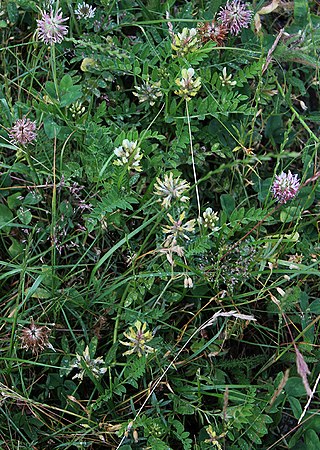
Potamogeton is a genus of aquatic, mostly freshwater, plants of the family Potamogetonaceae. Most are known by the common name pondweed, although many unrelated plants may be called pondweed, such as Canadian pondweed. The genus name means "river neighbor", originating from the Greek potamos (river) and geiton (neighbor).

Ruppia, also known as the widgeonweeds, ditch grasses or widgeon grass, is the only extant genus in the family Ruppiaceae, with eight known species. These are aquatic plants widespread over much of the world. The genus name honours Heinrich Bernhard Rupp, a German botanist (1688-1719). They are widespread outside of frigid zones and the tropics.

Nobuyuki Tanaka is an economic botanist at the Tokyo Metropolitan University, the Makino Botanical Garden in Kōchi Prefecture, Japan.

Halodule is a genus of plants in the family Cymodoceaceae described as a genus in 1841. It is widespread on tropical and semi-tropical ocean shores of all continents except Europe and Antarctica.

Lemna trisulca L. is a species of aquatic plants in the arum family Araceae. It has a subcosmopolitan distribution. Unlike other duckweeds, it has submerged rather than floating fronds, except when flowering or fruiting. Also unlike other duckweeds, a large number of fronds remain attached to each other at a time.

Potamogeton perfoliatus is a perennial aquatic plant in the family Potamogetonaceae occurring in both standing and flowing freshwater habitats. It is widely distributed globally, occurring in all continents except South America and Antarctica.

Potamogeton lucens, or shining pondweed, is an aquatic perennial plant native to Eurasia and North Africa. It grows in relatively deep, still or slow-flowing, calcareous freshwater habitats.

Ruppia maritima is an aquatic plant species commonly known as beaked tasselweed, beaked ditchgrass, ditch grass, tassel pondweed and widgeon grass. Despite its scientific name, it is not a marine plant; is perhaps best described as a salt-tolerant freshwater species. The generic name Ruppia was dedicated by Linnaeus to the German botanist Heinrich Bernhard Ruppius (1689–1719) and the specific name (maritima) translates to "of the sea".
Potamogeton maackianus is an aquatic plant species in the genus Potamogeton. It is found in slow moving fresh water.
Halodule pinifolia is a seagrass species in the genus Halodule. It is found in shallow sea waters.

Potamogeton octandrus is an aquatic plant species in the genus Potamogeton. It is found in slow-moving fresh water. The specific epithet means 'eight-stamened'.
Ruppia megacarpa is a submerged herb species in the genus Ruppia found in shallow brackish waters. It is a common on Australasian coasts, including Australia (NSW; SA; Vic; WA and New Zealand. Isolated populations have been currently found in East Asia, including Japan, Korea, and Far East Russia, hence, the species distribution exhibit latitudinally disjunct distribution between East Asia and Australasia.

Ruppia tuberosa is a submerged herb in the genus Ruppia found in shallow hypersaline waters in Australia.
Potamogeton × inbaensis is an inter-species hybrid in the genus Potamogeton. It is found in slow-moving fresh water.

Nechamandra is a monotypic genus of an aquatic plant family Hydrocharitaceae. The sole species is Nechamandra alternifolia. It is found in slow moving fresh water.
Chloroplast capture is an evolutionary process through which inter-species hybridization and subsequent backcrosses yield a plant with new genetic combination of nuclear and chloroplast genomes. For instance, 1) species A's pollen hybridizes (backcross) to species B's ovule, yielding the 1st hybrid (F1) with chloroplast genome b and nuclear genome A (50%) and B (50%); 2) species A's pollen again hybridizes (backcross) to F1's ovule, yielding the 2nd hybrid (F2) with chloroplast genome b and nuclear genome A (75%) and B (25%); 3) species A's pollen again hybridizes (backcross) to F2's ovule, yielding the 3rd hybrid (F3) with chloroplast genome b and nuclear genome A (87.5%) and B (12.5%); 4) after further backcross generations, a plant is obtained with the new genetic combination.

Caldesia parnassifolia, is an aquatic species in the Alismataceae. It is found in slow-moving fresh water.
Norio Tanaka is an aquatic botanist at Tsukuba Botanical Garden, National Science Museum, Tokyo, Japan.

Orchideae is a tribe of orchids in the subfamily Orchidoideae. Historically, it was divided into 2 subtribes, Orchidinae and Habenariinae. The subtribe Orchidinae alone contains about 1,800 species. However, although some phylogenetic studies have established the monophyly of the subtribes, the generic boundaries are unclear, with many genera as traditionally circumscribed being paraphyletic or even polyphyletic. Species of genera such as Habenaria and Platanthera have been placed into both subtribes. A 2017 molecular phylogenetic study found that both subtribes did form clades, but did not formally recognize Habenariinae, because of missing genera and uncertainty over generic boundaries. The Asian species of Orchideae, in particular, have been subject to repeated changes of generic placement from 2012 onwards.

Astragalus fragrans is a species of milkvetch in the family Fabaceae.














